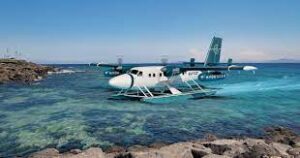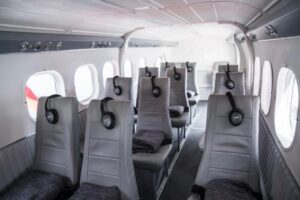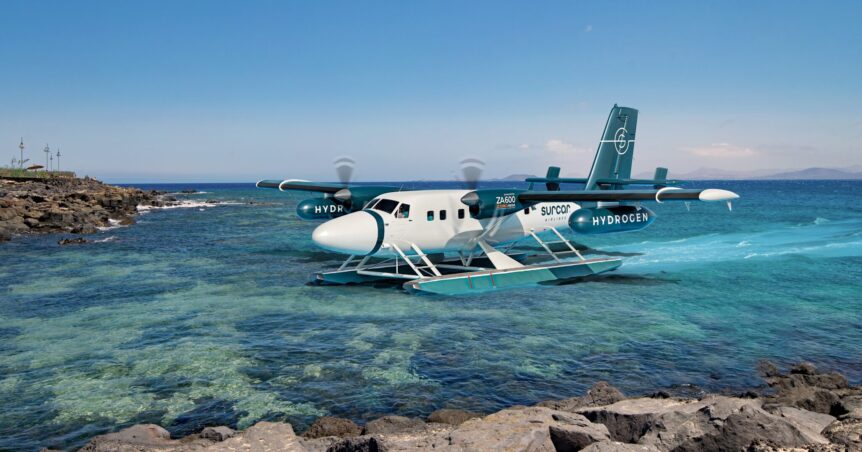An Island-Hopping Customer
Surcar Airlines is an enterprise based in the Canary Islands which hopes to serve its island routes with ZeroAvia-motored, hydrogen-fueled DeHavilland Twin Otters. But not right away.
Starting with conventionally-powered turbine twins, Surcar is working on a process, “Based on starting something totally new and that touches so many sectors at the same time.
“Today we confirm that we have signed an agreement with@zeroavia to fly its ZA600 hydrogen-electric engines in order to operate ecological flights.

DeHavilland Twin Otter in Surcar Airlines livery with ZA600 motors and H2 tanks under wings
“We will operate Twin Otter seaplanes updated with the ZA600 propulsion system on our sightseeing flights.” This 600 kilowatt (804 horsepower) system is now being tested and certified for aircraft seating nine to 19 passengers.
“This implies the commitment to lead the electrification of aviation in the Canary Islands and achieve zero-emission flights in the archipelago.”
This ambition drives the airline to follow, and possibly lead in the European Union’s aim to, “…Reduce greenhouse gas emissions by 55 percent by 2030 and Spain’s Integrated National Energy and Climate Plan proposes achieving a completely carbon-neutral transport system by 2050.”
Airline founder and CEO Gerardo Morales-Hierro explains, “Our business will start with conventionally powered aircraft. We will then switch to hydrogen electric motors, which will allow us to preserve the climate of these islands which attract millions of visitors each year. We hope this will encourage other operators to adopt a similar approach.”
ZeroAvia has a Memorandum of Understanding (MOU) with DeHavilland Air Canada, designer and builder of the airplane and holder of the Twin Otter type certificate. Continued testing of the motor and installation in Surcar’s Otters will probably take the next two to three years.
For its part, ZeroAvia considers the Canary Islands an ideal region for the first zero-emission flights due to the short air journeys that can be made from island to island.

Surcar Twin Otter interior is neatly set up to give passengers a quiet ride between islands
Surcar plans to use Twin Otter seaplanes retrofit with the ZA600 powertrain on sightseeing tours. The newly launched airline is backed by investors including the Danish carrier Nordic Seaplanes. Surcar Airlines is committed to spearheading the electrification of aviation to enable zero-emission flights in the Canary Islands. By pioneering captivating, green sightseeing flights, the company aims to inspire and drive other operators towards adopting sustainable practices, accelerating the transition to a cleaner future for the entire industry.
ZeroAvia’s Chief Customer Officer, James Peck, helps define the mission. “The Canaries are a perfect use case for the earliest zero-emission flights, given the opportunity for replacing combustion engines on short island-to-island routes. Developing green options for inter-island travel will help further increase the appeal of one of Europe’s most popular holiday destinations.”
Morales-Hierro adds, “Millions visit each year to see the incredible natural beauty and world heritage sites here in the Canary Islands. Climate change threatens this and our way of life. Working with ZeroAvia will help us to deliver cleaner flights, while also fostering positive impacts on the local community and the environment.”
How ZeroAvia is Preparing for a Green Future
Zeroavia founder and CEO Val Miftakhov explains his company’s all-encompassing goals, powering as many airplanes as possible with ZeroAvia motors and fuel cells.
Rudolf Goetz, Chief Technology Officer for Hydrogen, explains the process of converting H2 into electric power through the use of an advanced fuel-cell stack. ZeroAvia claims to extract about twice the power per kilogram of system weight as its competitors, an essential trait in anything that flies.
Another weighty problem for fuel cell-powered craft is that of storing the gaseous or liquid hydrogen. Traditionally, H2 tanks are hefty, partly because hydrogen leaks fairly readily, being the lightest element and comprising the smallest molecule. Despite these concerns, the U. S. Department of Energy gives hydrogen approval as being safer than many commonly used fuels.
“A number of hydrogen’s properties make it safer to handle and use than the fuels commonly used today. For example, hydrogen is non-toxic. In addition, because hydrogen is much lighter than air, it dissipates rapidly when it is released, allowing for relatively rapid dispersal of the fuel in case of a leak.”
From CGH2 to LH2 and Composite Tanks
Val Miftakhov thinks compressed gas hydrogen (CGH2) will suffice for current projects, “And then for another three to four years beyond that, we will use CGH2 in composite cylinders. We’re also looking at a number of conformable tank technologies from multiple manufacturers that are based on composites.”
Miftakhov adds, “We think larger aircraft, and eventually all aircraft, will move to cryogenic [liquid hydrogen] LH2. Our first application of LH2 will be for the 40-80-seat regional turboprops like the DeHaviland of Canada Dash 8 and ATR families with customers like Alaska Airlines in 2027. We see the most promising approach is using composite tanks and we are working with a couple of partners on that already.
With the ZA600 motor being tested on or slated for various airframes, green hydrogen becoming a viable reality, fuel cells becoming more efficient, and H2 storage becoming lighter, things look bright for (near) future clean aviation.

